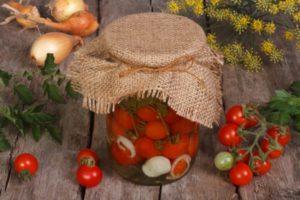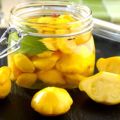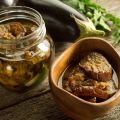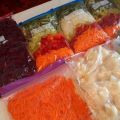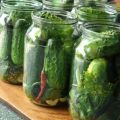The most popular recipes for canning pickles for the winter
Pickles from cucumbers for the winter - canning of small-sized vegetables. One can close gherkins, onions, baby tomatoes, small ears of corn or individual grains, green peas, green beans, which are also called "pickles".
Culinary experts from America add such preservation to sandwiches. Vegetables make an excellent appetizer for side dishes and meat, pickles are combined with any potato dish.
Necessary products
The ingredients for this recipe are enough to preserve about 4 liter jars.
Components:
- Vegetables: 25 gherkins, 30 pcs. cherry tomato, 1 head of cauliflower, 15 small carrots (about 3 - 5 cm in length), 300 g of small onions.
- Pepper peas - 10 pcs.
- Coriander - 20 grains
Now let's consider what and how to do so that in winter a delicious cucumber snack flaunts on the table.
Vegetable selection rules
To make everything look appetizing and original in cans, you should buy assorted vegetables of the same size. The cucumbers should be about the size of a little finger. This appetizer is prepared from overgrown cucumbers for the winter, but the vegetables are then cut into bars. Cherry tomatoes do not have to buy red - tomatoes are yellow, pink, striped.
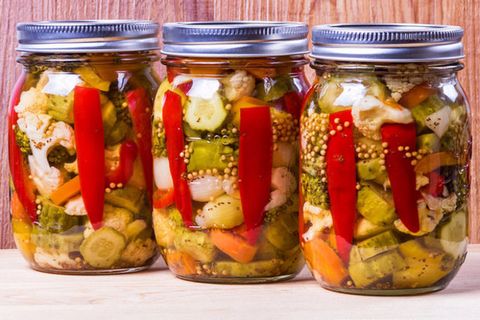
It is not always possible to find small carrots on the market, so you can take a regular size root vegetable and cut into small bars. You can buy cabbage not only white, but also purple. Pickled pickles in a jar alternate in layers, focusing on the color scheme. It turns out quite bright and original. To make the pickles crispy, put peeled horseradish on the bottom of the jar. Pickle tins are best used for 1.5 - 2 liters — it is more convenient to arrange the vegetable layers.
Canning stages
It is necessary to follow the recipe at all stages of canning vegetables for the winter. First, the vegetables are washed and the stalks are cut off. Dense root vegetables are peeled, and cauliflower is divided into bunches. At the preparatory stage, it is necessary to sterilize the jars.
Before marinating large root vegetables, they are cut into circles or wedges about the same size as the vegetables that will be preserved whole. Prepared food is poured into separate bowls for convenience.
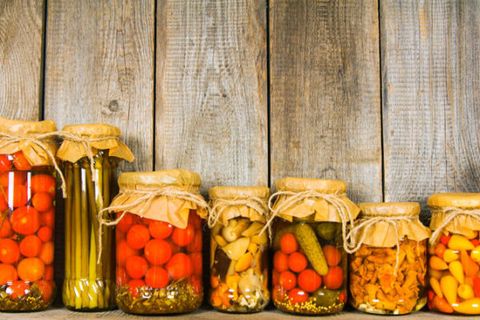
It is advisable to cut off the tips of cucumbers. Carrots and cabbage are lightly boiled (blanched). All inflorescences can be removed from cabbage. Large carrots are cut into thick rings or into 4 pieces.
Blanching is carried out by dipping a colander with vegetables into boiling water.A 5-minute boil is enough for the vegetables to reach the required condition, and after cooking they crunch when bitten.
Before laying in sterilized jars, vegetables are placed in separate containers, and then the hostess places them in layers one by one. It is advisable to alternate products of contrasting shades so that the canned assortment has an interesting color pattern.
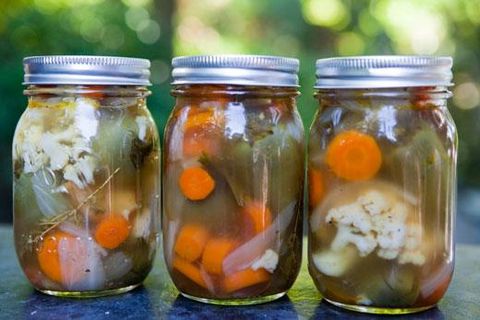
For example, you can put a layer of zucchini on the bottom, and then lay out the cherry tomatoes, place white cabbage on top, the next layer can be carrots or pickles, etc.
Pouring boiling water
Jars filled to the top are poured with boiling water. To prevent the glass from cracking during the infusion of hot water, the container is pre-filled by about 1/3 part, and after half a minute the water is poured almost to the neck.
Heating in the oven
After filling with boiling water, jars of pickles for the winter according to the recipe are covered with a lid and placed in the oven for heating. It is preheated to 100 degrees and jars are kept there, in which pickles are pickled for the winter, for 15 minutes. After that, the water is drained, and the jars are covered with a warm towel so that the containers do not cool down during the preparation of the marinade.
Cooking the marinade
The next step in this conservation is to prepare the liquid to marinate the pickles. The brine is prepared from the water that was poured out of the cans of canned vegetables. Based on 1 liter of boiling water, add the following ingredients: 50 g of salt and sugar, 10 black peppercorns, 20 coriander seeds.
The brine is boiled on the stove until the crystals of salt and sugar dissolve in water. At the end of cooking, add vinegar to the pan and cover the lid so that the acid does not evaporate. If desired, table vinegar can be replaced with apple cider vinegar or wine vinegar. After boiling, the ingredients are boiled in the marinade for 2 - 3 minutes, then poured into jars of vegetables.
The process of sterilizing cans of vegetables
Blanks of pickles for the winter are covered with lids (not hermetically sealed) and placed on a baking sheet of the oven. The temperature of ovens with an appropriate regulator is set to 200 degrees. The jars should be kept in the oven until air bubbles appear from the day of the jars. This indicates that the boiling process has begun. From now on, you need to set the timer for 20 minutes. After the containers are removed and hermetically rolled up using a special key, the lids for cans with a thread (twist-off) are simply turned all the way.
Can be prepared without sterilization. In this case, the banks are poured with boiling water 2 - 3 times. Now you know how to cook pickles.
To determine the tightness of the sealed lid, place the preservation jar on the flat surface of the table and observe if a chain of air bubbles has appeared in the jar. In this case, it is necessary to turn the seaming key again or tighten the twist-off cover.
Preservation with pickles is kept in the room until it cools completely, and then the blanks are lowered into the basement or transferred to the pantry for storage. Pickled vegetables are ready to eat and are obtained in 1 - 1.5 months, completely saturated with marinade.
